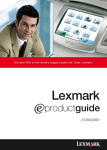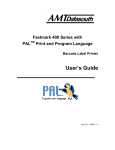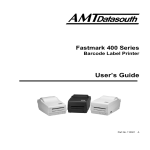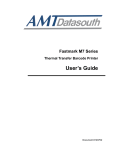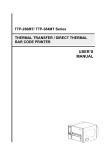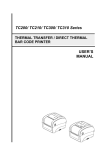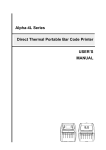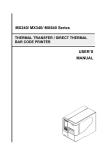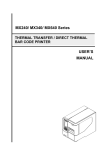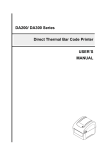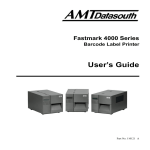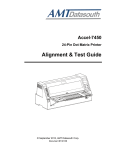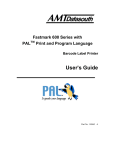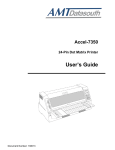Download AMT Datasouth Fastmark M4 Series User`s guide
Transcript
Fastmark M4 Series Portable Direct Thermal Bar Code Printer User’s Guide © April 2014, AMT Datasouth Corp. Document # 120424 Copyright Declaration Information in this manual is subject to change without notice and does not represent a commitment on the part of AMT Datasouth Corporation. No part of this manual may be reproduced or transmitted in any form by any means, for any purpose other than the purchaser’s personal use, without the expressed written permission of AMT Datasouth Corporation. Trademark Credits: CG is a registered trademark of Agfa Corporation. CG Triumvirate Bold Condensed font is under license from the Monotype Corporation. Windows is a registered trademark of Microsoft Corporation. All other trademarks are property of their respective owners. Regulatory Agency Approvals: Part 15B/C EN 60950-1 EN 55022/24, IEC 61000-3-3, IEC 61000-3-2 EN 300328, EN 301489 - ii - http://www.amtdatasouth.com/support-1/downloads/ Regulatory Statements: Wichtige Sicherheits-Hinweise 1. Bitte lesen Sie diese Hinweis sorgfältig durch. 2. Heben 3. Sie diese Anleitung fűr den späteren Gebrauch auf. Vor jedem Reinigen ist das Gerät vom Stromentz zu trennen. Verwenden Sie keine Flüssig-oder Aerosolreiniger. Am besten eignet sich ein angefeuchtetes Tuch zur Reinigung. 4. Die Netzanschluß-Steckdose soll nahe dem Gerät angebracht und leicht zugänglich sein. 5. Das 6. Gerät ist vor Feuchtigkeit zu schűtzen. Bei der Aufstellung des Gerätes ist auf sicheren Stand zu achten. Ein Kippen oder Fallen könnte Beschädigungen hervorrufen. 7. Beachten Sie beim Anschluß ans Stromnetz die Anschlußwerte. 8. Dieses Gerät kann bis zu einer Außentemperatur von maximal 40℃ betrieben warden. Battery safety warning: DO NOT throw the battery in fire. DO NOT short circuit the contacts. DO NOT disassemble the battery. DO NOT throw the battery in municipal waste. The symbol of the crossed out wheeled bin indicates that the battery should not be placed in municipal waste. CAUTION Risk of explosion if battery is replaced by an incorrect type. Dispose of used batteries according to the instructions - iii - FEDERAL COMMUNICATIONS COMMISSION INTERFERENCE STATEMENT This equipment has been tested and found to comply with the limits for a Class B digital device, pursuant to part 15 of the FCC Rules. These limits are designed to provide reasonable protection against harmful interference in a residential installation. This equipment generates, uses and can radiate radio frequency energy and, if not installed and used in accordance with the instructions, may cause harmful interference to radio communications. However, there is no guarantee that interference will not occur in a particular installation. If this equipment does cause harmful interference to radio or television reception, which can be determined by turning the equipment off and on, the user is encouraged to try to correct the interference by one or more of the following measures: -Reorient or relocate the receiving antenna. -Increase the separation between the equipment and receiver. -Connect the equipment into an outlet on a circuit different from that to which the receiver is connected. -Consult the dealer or an experienced radio/ TV technician for help. This device complies with Part 15 of the FCC Rules. Operation is subject to the following two conditions: (1) This device may cause harmful interference, and (2) this device must accept any interference received, including interference that may cause undesired operation. CAUTION: Any changes or modifications not expressly approved by the grantee of this device could void the user's authority to operate the equipment. RF exposure warning (WiFi) This equipment must be installed and operated in accordance with provided instructions and must not be co-located or operating in conjunction with any other antenna or transmitter. End-users and installers must be providing with antenna installation instructions and transmitter operating conditions for satisfying RF exposure compliance. SAR Value: 0.663 W/kg - iv - RF exposure warning (For Bluetooth) The equipment complies with FCC RF exposure limits set forth for an uncontrolled environment. The equipment must not be co-located or operating in conjunction with any other antenna or transmitter. Canada, Industry Canada (IC) Notices This Class B digital apparatus complies with Canadian ICES-003 and RSS-210. Operation is subject to the following two conditions: (1) this device may not cause interference, and (2) this device must accept any interference, including interference that may cause undesired operation of the device. Radio Frequency (RF) Exposure Information The radiated output power of the Wireless Device is below the Industry Canada (IC) radio frequency exposure limits. The Wireless Device should be used in such a manner such that the potential for human contact during normal operation is minimized. This device has been evaluated for and shown compliant with the IC Specific Absorption Rate (“SAR”) limits when installed in specific host products operated in portable exposure conditions. (For WiFi) This device has also been evaluated and shown compliant with the IC RF Exposure limits under portable exposure conditions. (antennas are less than 20 cm of a person's body). (For Bluetooth) Canada, avis d'Industry Canada (IC) Cet appareil numérique de classe B est conforme aux normes canadiennes ICES-003 et RSS-210. Son fonctionnement est soumis aux deux conditions suivantes : (1) cet appareil ne doit pas causer d'interférence et (2) cet appareil doit accepter toute interférence, notamment les interférences qui peuvent affecter son fonctionnement Informations concernant l'exposition aux fréquences radio (RF) La puissance de sortie émise par l’appareil de sans fil est inférieure à la limite d'exposition aux fréquences radio d'Industry Canada (IC). Utilisez l’appareil de sans fil de façon à minimiser les contacts humains lors du fonctionnement normal. Ce périphérique a été évalué et démontré conforme aux limites SAR (Specific Absorption Rate – Taux d'absorption spécifique) d'IC lorsqu'il est installé dans des produits hôtes particuliers qui fonctionnent dans des conditions d'exposition à des appareils portables. (For WiFi) Ce périphérique a également été évalué et démontré conforme aux limites d'exposition aux RF d'IC dans des conditions d'exposition à des appareils portables. (les antennes sont moins de 20 cm du corps d'une personne). (For Bluetooth) -v- Table of Contents User Caution...................................................................................................................8 Packaging .......................................................................................................................9 Unpacking the printer .................................................................................................................................... 9 Removing protective material ........................................................................................................................ 9 Introduction .................................................................................................................. 10 Product ........................................................................................................................................................ 10 Key features ................................................................................................................................................. 10 Printer Overview .......................................................................................................... 11 Front view .................................................................................................................................................... 11 Rear view ..................................................................................................................................................... 12 Operator Controls ........................................................................................................ 13 LED indication and keys .............................................................................................................................. 13 Setup ............................................................................................................................. 15 Installing the belt clip and battery ................................................................................................................ 15 Battery charging........................................................................................................................................... 16 Connecting the printer interface .................................................................................................................. 25 Cable communications ................................................................................................................................ 25 Wireless communication with Bluetooth ...................................................................................................... 25 Wireless communications with WiFi ............................................................................................................ 26 Environmental case with shoulder strap installation .................................................................................... 26 Paper core adapter (0.75” ~ 1”) installation ................................................................................................. 27 Power-ON Utilities........................................................................................................ 29 Power-ON Utility for standard panel ............................................................................................................ 29 Media sensor calibration .............................................................................................................................. 29 Printer initialization....................................................................................................................................... 30 Self-test and Dump Mode ............................................................................................................................ 30 Power-ON Utility for standard panel ............................................................................................................ 30 Self-test ........................................................................................................................................................ 31 Dump Mode ................................................................................................................................................. 32 Printer defaults............................................................................................................................................. 32 PALTM Print and Program Overview ........................................................................... 33 Traditional printing ....................................................................................................................................... 33 Legacy data stream interpretation ............................................................................................................... 33 Standalone/downtime applications .............................................................................................................. 34 ~6~ Diagnostic Tool ............................................................................................................ 36 Starting diagnostic tool ................................................................................................................................ 36 Printer functions ........................................................................................................................................... 37 Setting Bluetooth configuration .................................................................................................................... 38 Setting WiFi configuration ............................................................................................................................ 39 LCD Menu Function (Optional) ................................................................................... 40 LCD menu setup .......................................................................................................................................... 40 Menu icon and functions .............................................................................................................................. 40 Main menu overview .................................................................................................................................... 42 Setup ........................................................................................................................................................... 43 Printer setup for TSPL2 .......................................................................................................................... 43 Printer setup for ZPL2 ............................................................................................................................ 45 Sensor .................................................................................................................................................... 48 Serial communication ............................................................................................................................. 49 Wireless LAN .......................................................................................................................................... 50 Bluetooth ................................................................................................................................................ 50 Date / Time ............................................................................................................................................. 51 Display .................................................................................................................................................... 51 File Manager........................................................................................................................................... 52 Diagnostics .................................................................................................................. 53 Print Configuration ....................................................................................................................................... 53 Dump Mode ................................................................................................................................................. 53 Battery ......................................................................................................................................................... 54 Print Head .................................................................................................................................................... 54 Language ..................................................................................................................................................... 54 Service ......................................................................................................................................................... 54 Troubleshooting ........................................................................................................................................... 55 Maintenance ................................................................................................................................................ 57 Product Characteristics .............................................................................................. 58 Printer specifications ................................................................................................................................... 58 Bar code symbologies ................................................................................................................................. 59 Optional features ......................................................................................................................................... 59 General ........................................................................................................................................................ 60 Media ........................................................................................................................................................... 61 ~7~ Operational safety User Caution CAUTION Refer to the product label (back of the printer) and verify your power source exactly meets those requirements. Mechanical and electrical repairs should be conduct by qualified service personnel. Do not use this product near heat or water while utilizing AC power outlet. Unplug this product from the power outlet before cleaning. Cautions in setting up CAUTION Unpack the printer. Make sure that the printer body and all accessories are included in the package and no parts are damaged. Battery charge takes 5~6 hours before the first time usage. While charging the status LED color is solid amber, fully charged green. Battery Safety: DO NOT short circuit the contacts. DO NOT disassemble the battery. DO NOT throw the battery in municipal waste. Before connecting or disconnecting the USB/Serial cable, be sure to turn off the printer. Do not use the printer in any location subject to sudden changes in temperature, humidity or heat generating equipment. Do not connect the printer AC adaptor to a non-standard power source. Refer to safety label on adapter. Refer to print adjustments in this manual before attempting alignments. Do not turn off the printer during printing, as this may lead to a malfunction. If the case or cover becomes dirty, clean it with a soft cloth moistened with a small quantity of neutral detergent diluted with water. Never use a hard cloth or volatile solvent such as alcohol, thinner, or benzene. ~8~ Packaging Unpacking the printer Portable Printer Battery Belt Clip CD ROM AC Adaptor Quick Start Guide Removing protective material 1. 2. 3. This printer has been specially packaged to withstand damage during shipping. Please carefully inspect the packaging and printer upon receipt. Open the carton and remove the printer from bubble wrap. If any parts are missing, please contact the Customer Service Department of your purchased reseller or distributor. It is recommended to keep packaging materials for future use if needed. ~9~ Introduction Product Thank you very much for purchasing your AMT Datasouth bar code printer. The Fastmark M4 is a, light-weight portable printer efficient for printing quick and trouble-free labels or receipts on demand. The Fastmark M4 is designed for a rough life, inside the IP54-rated environmental case to resist dust and water and with its rubber over-mold design prepared to take up to a five foot fall and keep printing. These small and light printers can be worn comfortably for a full shift, without interfering with the user’s tasks. Use USB, Bluetooth, optional 802.11 b/g/n Wireless or serial to connect to a mobile computer or even a smart phone and produce clear easy-to-read labels or receipts hour after hour. Applications: Point of sale Healthcare patient safety Work in process Distribution Shipping/ receiving Retail Compliance labeling Order fulfillment Logistics receipts Ticketing Key features IP54 rated protective case to resist dust and water Plastic design with rubber over-mold construction that withstands 5-foot drop Ready for EPL, ZPL, CPCL or PAL environments, WinCE QuickLink tool & SDK and iOS SDK Wired & Wireless communications (USB 2.0, RS-232, Bluetooth, and 802.11 b/g/n) Linerless media ready High-speed processor and extensive memory for fast print speeds of up to 4-inches per second 2-year limited warranty ~ 10 ~ Printer Overview Front view 1 2 4 3 6 5 7 8 10 9 12 13 11 14 15 1. Power on/off button 2. Feed button 3. Printer status LED indicator 4. Battery status LED indicator 5. Media cover release button 6. Peel-off sensor 7. Print head 8. Transmissive Gap sensor 9. Media holder lock switch 10. Media holder 11. Media cover 12. Reflective Black Mark sensor 13. Platen roller 15. Peeler module 14. Tear/Peeler bar *The media sensor position (#12) is selectable by factory adjustment (L/C/R). Default is the center position. ~ 11 ~ Rear view 2 1 3 4 5 6 8 7 1. 3. 5. 7. Li-ion battery Battery open clasp External label entrances chute *Micro SD card socket 2. 4. 6. 8. Belt clip Shoulder strap hanger USB interface Power jack *Recommended Micro SD card specifications SD card spec SD card capacity Approved SD card manufacturer V1.0, V1.1 MicroSD 128 MB Transcend, Panasonic V1.0, V1.1 MicroSD 256 MB Transcend, Panasonic V1.0, V1.1 MicroSD 512 MB Transcend, Panasonic V1.0, V1.1 MicroSD 1 GB Transcend, Panasonic V2.0 SDHC CLASS 6 MicroSD 4 GB Transcend The DOS FAT file system is supported for the SD card. Folders/files stored in the SD card should be in the 8.3 filename format ~ 12 ~ Operator Controls LED indication and keys Keys LED’s Function Press and hold for 2-3 seconds to turn on the printer Press and hold for 2-3 seconds to turn off the printer Ready status: Feed one label Printing status: Pause the print job Status Indication Full charged Green (solid) 2/3 charged level Green (solid) 1/3 Charged level Green (blinking) Low battery Amber (solid) Battery is charged Blue (solid) Bluetooth device is ready Blue (blinking) Bluetooth device is communicating Blue (solid) WiFi device is ready Blue (blinking) WiFi device is communicating NOTE: WiFi device is optional Off Printer is ready Green (Blinking) Printer is paused Printer is downloading data Red (solid) Media cover is open Out of memory Red (blinking) No paper Paper jam Clean data Amber (solid) Printer busy ~ 13 ~ LED indication and keys for LCD (optional) Keys Function − − − − − − − − − − LEDs Error Power Display the printer information Button for LCD setting menu Enter the printer setting menu Button for LCD setting menu Press and hold for 2-3 seconds to turn on the printer Press and hold for 2-3 seconds to turn off the printer Button for LCD setting menu Ready status: Feed one label Printing status: Pause the print job Button for LCD setting menu Status Indication Off Printer is ready − Media cover is open − Out of memory Red (solid) − Clean data − Printer is busy − No paper Red (blinking) − Paper jam Off Printer power is turned off − Printer power is turned on Green (solid) − Battery is full charged Green (blinking) Low battery Amber (solid) Battery is charging LCD Indication Printer has been connected with cable Bluetooth devices have been paired Wi-Fi device has been connected XX Battery capacity % ~ 14 ~ Setup Installing the belt clip and battery 1. 2. 3. Insert the belt clip first. Insert the left side to install the battery at the rear of the printer. PUSH Push the right side of the battery. Battery safety warning: DO NOT throw the battery in fire. DO NOT short circuit the contacts. DO NOT disassemble the battery. DO NOT throw the battery in municipal waste. The symbol of the crossed out wheeled bin indicates that the battery should not be placed in municipal waste. ~ 15 ~ Battery charging It takes 5~6 hours to fully charge the battery before the first time usage. The lifetime of the battery is 300 times for charge/discharge cycles. 1. 2. 3. 4. ~ 16 ~ The battery is installed into the printer. Open the interface cover and plug the power cord to the power jack. Plug the power cord into a properly power outlet. When the battery is changing, the color of battery status LED indicator is solid amber. Loading media 1. 2. 3. ~ 17 ~ Open the printer media cover by pressing the media cover release button. Pull the media holders apart to fit the label roll width. Place the roll (print side up) between the media holders and close them onto the core. Pull paper past the print head. 4. Press each side of media cover to close the media cover and make sure the media cover closed correctly. Media Calibration: Calibrate the gap/black mark sensor when changing media. Turn ON the printer and open/close the media cover. The printer will automatically calibrate. ~ 18 ~ Loading media in Peel-off Mode 1. 2. 3. ~ 19 ~ Refer to above Loading Media section and insert label roll. Open/close media cover to perform calibration. Feed one or two lables from the printer and remove the label(s) from the liner. Close the media cover by pressing both sides down. Be sure the cover is latched on both sides. 4. Feed the liner through the module as shown. 5. Pull liner to remove the slack. 6. Move the peeler module to near the peeler bar by pushing each side of the module. (cover the platen roller). ~ 20 ~ 7. Press down on the peeler module to lock into place. 8. Loosen and remove media and carrier in reverse order. ~ 21 ~ Loading fan-fold/external media 1. Open the printer media cover by pressing the media cover release button. Pull the media holders apart to fit the media width. 2. Push down each side of media holder lock switch to fix the media holder. 3. Feed the media (print side up) through the rear external label entrance chute. ~ 22 ~ 4. Press each side of media cover to close the media cover and make sure the media cover closed correctly. Media Calibration: Calibrate the gap/black mark sensor when changing media. Turn ON the printer and open/close the media cover. The printer will automatically calibrate. ~ 23 ~ Loading linerless media (requires linerless printer) 1. Push down each side of media holder lock switch to affix linerless media roll. 2. Place the paper, printing side face up, and pull out one or two labels/paper past the print head. 3. Press each side of media cover to properly close the cover. Verify the cover is completely closed to avoid feed or print discrepancies. 4. Perform a media calibration. ~ 24 ~ Connecting the printer interface The printer must establish communication with a host terminal which sends the data to be printed. There are three ways to connect for Fastmark M4 series printer. By a USB cable between the printer and its host terminal By a Bluetooth short-range radio By a Wireless LAN per 802.1 b/g (Optional) Cable communications USB connector (Printer) USB/RS-232 connector (PC) 1. Open the interface cover and connect the printer to the computer/smart phone (host terminal) with USB cable. (USB to USB or USB to RS-232) Wireless communication with Bluetooth 1. 2. Turn on the printer. 3. Connect the Bluetooth devices. The Bluetooth LED will turn on blue (the Bluetooth icon will be shown for LCD panel) if devices have been paired. Open the Bluetooth device for host terminal to scan for printer’s Bluetooth device Printer Bluetooth default Address You can find the printer address by printing the configuration (self-test) page. Name BT-SPP (Use DiagTool to change NAME) PIN 0000 (Use DiagTool to change PIN) ~ 25 ~ Wireless communications with WiFi (optional) Refer to DiagTool instructions to set Non LCD display units. Printers with a LCD display can be set via DiagTool or control panel buttons. For control panel setup refer to the “LCD Menu Function” section. Environmental case with shoulder strap installation (optional) 1. Open case top cover. 2. Insert the printer as shown. 3. Close the case top cover. The outside cover should be opened while printing. ~ 26 ~ Paper core adapter (0.75” ~ 1”) installation (optional) 1. Required parts: a. Adapter x2 b. Screw x2 c. Nut x2 2. Insert nut into media holder. 3. Align arrow as shown. ~ 27 ~ 4. 5. ~ 28 ~ Pull apart the media holders (max amount) and lock into place. With adapter in place, hold nut, insert and tighten the screw. Power-ON Utilities There are three power-ON utilities to set up and test printer hardware. These utilities are activated by pressing the FEED button ( ) then turning on the printer power ( ) simultaneously and release the button at different LED light indications. Power-ON Utility for standard panel (No LCD Display) Follow the steps below for different power-on utilities. 1. 2. 3. Turn off the printer power switch. 4. The printer will beep twice, then release the FEED ( battery LED indicates the desired function: Press down the FEED button ( ) then turn on the power switch ( ). Release the power switch ( ) when LED color turns to amber, continue pressing the FEED button. Power ON Utilities Standard Panel ) button when the Battery LED Configurations LED (5 blinks) Release FEED button for (5 blinks) Media sensor calibration different functions Media sensor calibration, self- test and enter DUMP Mode (5 blinks) Printer initialization Media sensor calibration Follow the steps below to calibrate the media sensor. 1. 2. 3. Turn off the printer power switch. 4. The printer will beep twice, then release the FEED ( ) button when the battery LED indicates and blinking. The LED will sequence right to left, 5 blinks each. 5. The printer will calibrate the sensor and print out the internal settings, then enter the DUMP mode. Turn the printer OFF/ON to exit DUMP mode. Hold on the FEED button ( ) then turn on the power switch ( Release the power switch ( ) when continue pressing the FEED button. ~ 29 ~ ). LED color turn on amber, Printer initialization Printer initialization is used to clear DRAM and restore printer settings to defaults. 1. 2. 3. Turn off the printer power switch. 4. The printer will beep twice, then release the FEED ( ) button when the battery LED indicates and blinking. The LED will sequence right to left, 5 blinks each. 5. The printer will restore printer settings to defaults Hold on the FEED button ( ) then turn on the power switch ( ). Release the power switch ( ) when LED color turn on amber, continue pressing the FEED button. Self-test and Dump Mode Follow the steps below to calibrate the media sensor. 1. 2. 3. Turn off the printer power switch. 4. The printer will beep twice, then release the FEED ( ) button when the battery LED indicates and blinking. The LED will sequence right to left, 5 blinks each. 5. The printer will calibrate the sensor and print out the internal settings, then enter the DUMP mode. Turn the printer OFF/ON to exit DUMP mode. Hold on the FEED button ( ) then turn on the power switch ( ). Release the power switch ( ) when LED color turn on amber, continue pressing the FEED button. Power-ON Utility for standard panel (With LCD Display) Follow the steps below for different power-ON utilities. 1. 2. 3. Turn off the printer power switch. Press down the FEED button ( Release the power switch ( pressing the FEED button. ) then turn on the power switch ( ). ) when “Error” LED turns to red, continue ~ 30 ~ 4. The printer will beep twice, then release the FEED ( ) button when the LCD indicates the desired function; “Calibrate” or “Self-test” or “Initialize”. Power ON Utilities Standard Panel LCD Release FEED button for LCD Configurations Calibrate..… Self Test..… (5 dots) (5 dots) Media sensor calibration different functions Media sensor calibration, self- test and enter DUMP Mode Initialize..… (5 dots) Printer initialization Turn the printer OFF/ON to exit utility mode. Self-test The printer will print the printer configuration after media sensor calibration. Selftest printout can be used to check if there is any print head dot damage, printer configurations and available memory space. } } } } Printer model name & Main board firmware version Printer serial number Printed mileage Main board firmware checksum Serial port setting Code page Country code Print speed Print darkness Label size (width, height) Gap/Black mark (vertical gap, offset) Sensor sensitivity Battery voltage Print head temperature Print head average resistance Bad dots of print head Bad print head dots Bluetooth settings information WiFi settings information File management information Print head test pattern ~ 31 ~ Dump Mode The printer will enter dump mode after printing the configuration page. In the dump mode, all characters will be printed in 2 columns as following. The left side characters are received from your system and right side data are the corresponding hexadecimal value of the characters. It allows users or engineers to verify and debug the program exceptions. ASCII Data Hexadecimal Data Dump mode requires 4” wide paper width setting. Turn off / on the power or press FEED button to resume printer for normal printing. (Ready mode) Printer defaults Printer configuration will be restored to defaults as below after initialization. Parameter Speed Density Media Width Media Height Sensor Type Print Direction Reference Point Gap Offset Post-Print Action Serial Port Settings Code Page Country Code Clear Flash Memory Default setting 50.8 mm/sec (2 ips) 8 4” (101.5 mm) 4” (101.5 mm) Gap sensor 0 0,0 (upper left corner) 0 Tear mode 9600 bps, none parity, 8 data bits, 1 stop bit 850 001 No Media Calibration: Perform media calibration when completing the Initialization. Turn ON the printer and open/close the media cover. ~ 32 ~ PALTM Print and Program Overview Printers featuring PALTM Print and Program ability can be used in several ways in any given environment. This section describes 3 common ways this advanced capability is used. For help and assistance determining the best way to use this ability in your situation, please consult your sales representative. Traditional printing This environment represents the most common use of printers. Generally a single print job (PALTM print sequences) generates a single label. In this role the PALTM Print and Program interpreter accepts the print job, performs the required operator processing and prints the; label, tag, or ticket. Using a Windows driver in conjunction with a Windows application program is a typical way to print in this environment. Alternatively, PALTM print sequences may also be generated by any host application written to take advantage of this powerful language. When a PALTM capable printer is used this way, no special “PALTM program” must be loaded on the printer. Print sequences generated by a Windows driver or host program are simply sent to the printer resulting in print output just like traditional printers. Legacy data stream interpretation PALTM Print and Program capable printers uniquely address applications where upgrading to modern cost effective technology is desired. Often cost-prohibitive software reprogramming to change a data stream prevents an organization from moving to new printing technologies ~ 33 ~ Using a PALTM Print and Program capable printer solves this problem. In this case a PALTM program is written which interprets a data stream normally sent to the legacy device being replaced. This program is stored on the printer and is automatically executed each time the printer is powered on. This program is able to produce a new label format based on this legacy data. Even though the host computer is sending the exact same legacy data to the printer, the label format can be completely different. For example the new format may include bar codes, scaled and/or rotated fonts, lines, logo's etc. Even though the legacy device being replaced does not support these print abilities, the new label format can. For example, text only outputs such as produced by a dot-matrix printer or card embosser may now be presented in a more functional format. Information in the data stream can be reformatted into any size font in any rotation, or even printed as bar code. This example demonstrates how PALTM Print and Program capable printer can replace a legacy print device with no host software changes required. PAL Data Stream Application Legacy Data Stream PAL Interpreter Printer Flash Memory Printed Document Legacy Data Stream Host System PAL Printer Standalone/downtime applications PALTM Print and Program capable printers may be programmed to operate independent of a PC/host connection. This standalone ability may be used in cases where no PC/host connection is needed or as a fail-safe backup when the PC/host or network is unavailable. The Standalone Application program is stored in the printer memory and can accept input from a PS/2 keyboard, bar code scanner, or other serial devices such as an electronic scale. These programs may use the printer’s LCD to prompt for user input and may also include databases. Unlike other bar code printers that allow basic static forms to be loaded in the printer, PALTM Print and Program capable printers provide advanced abilities. ~ 34 ~ Examples of these advanced capabilities are: Ability to operate on line from host or off line in stand-alone mode Ability to range check user input Ability to combine data from multiple fields into a single bar code Ability to access database stored in printer Ability to perform math calculations (addition, subtraction, multiplication, division, etc.) Ability to perform logical calculations (equal to, less than, greater than, etc.) Shown below is an example where a stand-alone PALTM application and database is stored in the printer. Operator input combined with internal database information is used to create a label. For example, this application could request a part number and physical dimensions of a particular part by prompting for this information on the printer LCD. After the operator inputs the requested information on the PS/2 keyboard, the printer could calculate the volume, and then based on the part number lookup the part description in a database to produce a label. Local Database PAL Standalone Application Keyboard Data PAL Interpreter Printer Flash Memory Printed Document Operator Input PAL Printer Keyboard ~ 35 ~ Diagnostic Tool The Diagnostic Utility is a toolbox that allows users to explore the printer's settings and status; change printer settings; download graphics, fonts, and firmware; create printer bitmap fonts; and to send additional commands to the printer. Using this convenient tool, you can explore the printer status and settings and troubleshoot the printer. Starting diagnostic tool 1. Double click on the Diagnostic tool icon software. 2. There are four features (Printer Configuration, File Manager, Bitmap Font Manager, Command Tool) included in the Diagnostic utility. to start the Features tab Interface Printer functions Printer setup Printer status ~ 36 ~ Printer functions (Calibrate sensor, media setup, RTC setup…) 1. 2. 3. 4. Connect the printer and PC via USB cable. Turn ON printer and start DiagTool utility. Click the “Function” button for settings. The detail functions in the Printer Function Group are listed as below. Function Calibrate Sensor Ethernet Setup RTC Setup Factory Default Description Calibrate the sensor specified in the Printer Setup group media sensor field Setup the IP address, subnet mask, gateway for the on board Ethernet Synchronize printer Real Time Clock with PC Initialize the printer and restore the settings to factory default. Reset Printer Reboot printer Print Test Page Print a test page Configuration Page Print printer configuration Dump Text To activate the printer dump mode. Ignore AUTO.BAS Ignore the downloaded AUTO.BAS program Exit Line Mode Exit line mode. Password Setup Set the password to protect the settings For more information about Diagnostic Tool, please refer to the diagnostic utility quick start guide on the CD disk \ Diagnostic Utilities directory. ~ 37 ~ Setting Bluetooth configuration 1. 2. 3. 4. 5. 6. Connect the printer and PC via USB cable. Turn ON printer and start DiagTool utility. Select “Wireless” tab and click on “Built-in wireless module” item. Enter the new BT Local Name or BT PIN Code in the editor. Press “Set” button to set the new BT name or BT PIN code of the printer. Press “Get” button to get back the settings. Make sure the Bluetooth module settings are set properly. 3 4 Bluetooth Local Name BT-SPP Bluetooth PIN Code 0000 5 6 DiagTool Utility via Bluetooth : After initial setup, DiagTool calibration and user settings can be made using the Bluetooth interface connection. ~ 38 ~ Setting WiFi configuration 1. 2. 3. 4. 5. 6. Connect the printer and PC via USB cable. 7. The Wi-Fi LED will turn on blue (the Wi-Fi, icon will be shown for LCD panel) if device has been connected. 8. 9. Print out the self-test page to confirm correct settings. Turn ON printer and start DiagTool utility. Select “Wireless” tab and click on “Built-in wireless module” item. Enter the new WLAN settings in the editor. Press “Set” button to set the new settings to the printer. Press “Get” button to get back the settings. Make sure the Bluetooth module settings are set properly. Remove the USB cable and print WiFi data for test. 3 4 WLAN SSID Dlink WLAN Encryption WLAN Key WLAN DHCP ON 5 6 DiagTool Utility via WiFi : After initial setup, DiagTool calibration and user settings can be made using the WiFi interface connection. ~ 39 ~ LCD Menu Function (Optional) The Fastmark M4 series offer the LCD panel for selection to further enhance its capabilities to meet the demands of a wide range of printing solutions. This optional feature includes LCD control panel, 4 buttons and 2 LED display. LCD menu setup 1. Press the “M” button to enter the setting menu. 2. Use the four buttons to scroll through the menu, select and save a setting, or return to a previous menu. The black highlight indicates the selected setting. Menu icon and functions Icon Function Display printer information Enter setting menu Power switch Scroll up Scroll down Return to previous menu Enter to next menu Enter setting mode Exit setting mode Save the selected settings and return to previous menu Select Alter to OFF Alter to ON ~ 40 ~ 3. Press 4. Press button to enter the “Print Setup” item. Select the “TSPL2” item. Enter the “Speed” setting mode. 5. At this status, you can scroll up or scroll down to select the value of print speed. Then press the button to save the selected value into the printer. Press “ ” button to go back to “Ready mode. button to enter the “Setup” item. ~ 41 ~ Main menu overview Main Menu Setup File Manager Diagnostic Language Service ↓ ↓ ↓ ↓ ↓ Printer DRAM Print Config English Initialization ↓ ↓ ↓ Sensor Flash Dump Mode ↓ ↓ Serial Battery ↓ ↓ *Wireless Print Head ↓ Bluetooth ↓ Date/Time ↓ Display NOTE: The WiFi (Wireless) LAN function is optional for the Fastmark M4 series printers. ~ 42 ~ Setup This “Setup” category is used to configure the sensor, serial communications, wireless, Bluetooth, date time and display settings. Printer setup for TSPL2 Speed Density Direction Print Mode Offset Main Menu TSPL2 Setup Shift X Shift Y Reference X Reference Y Code Page Country Item Speed Density Description Use this item to setup print speed. The each increase or decrease is 0.5 ips. Available setting is from 1 to 6. Use this option to setup printing darkness. The available setting is from 0 to 15, and the step is 1. You may need to adjust your density based on selected media. Default 2 8 The direction setting value is either 1 or 0. Use this item to setup the printout direction. DIRECTION 0 FEED Direction DIRECTION 1 ~ 43 ~ 0 This item is used to set the print mode. There are 3 modes as below, Printer Mode Print mode None Batch Mode Peeler Mode Offset Shift X Shift Y Reference X Reference Y Code page Country Description Next label top of form is aligned to the print head burn line location. (Tear Off Mode) Once image is printed completely, label gap/black mark will be fed to the tear plate location for tear away. Enable the label peel off mode. This item is used to fine tune media stop location. Available setting value is from “+” to “-” or “0” to “9”. This item is used to fine tune print position. Available setting value is from “+” to “-” or “0” to “9”. This item is used to set the origin of printer coordinate system horizontally and vertically. Available setting value is from “0” to “9”. Use this item to set the code page of international character set. Use this option to set the country code. NOTE: If printing from enclosed software/driver, the software/driver will send out the commands, which will overwrite the settings set from the panel. ~ 44 ~ Batch Mode +000 +000 +000 000 000 850 001 Printer setup for ZPL2 Density Print Speed Tear Off Print Mode Print Width List Fonts List Images Main Menu Setup ZPL2 List Formats List Setup Control Prefix Format Prefix Delimiter Character Media Power Up Head Close Left Position Definition of options next page ~ 45 ~ Item Description Density Use this item to setup printing darkness. The available setting is from 0 to 30, and the step is 1. You may need to adjust your density based on selected media. Print Speed Tear Off Print Mode Default Use this item to setup print speed. The each increase or decrease is 1 ips. Available setting is from 1 to 6. This item is used to fine tune media stop location. Available setting value is “+” or “-” from “0” to “9”. Printer Mode Description Tear Off Mode Next label top of form is aligned to the print head burn line location. Peeler Mode Enable the label peel off mode. 16 2 +000 Tear Off The above options are used to set media present modes. Print Width This item is used to set print width. The available value is from “0” to “9”. 812 List Fonts This feature is used to print current printer available fonts list to the label. The fonts stored in the printer’s DRAM, Flash or optional memory card. N/A List Images This feature is used to print current printer available images list to the label. The images stored in the printer’s DRAM, Flash or optional memory card. N/A List Formats This feature is used to print current printer available formats list to the label. The formats stored in the printer’s DRAM, Flash or optional memory card. N/A List Setup This feature is used to print current printer configuration to the label. N/A This feature is used to set control prefix character. N/A This feature is used to set format prefix character. N/A This feature is used to set delimiter character. N/A Control Prefix Format Prefix Delimiter Character Continued on next page ~ 46 ~ Printer Option Feed Calibration Media Power Up Description Printer will advance one label. Printer will calibrate the sensor levels, determine length and feed label. Length Printer determines length feeds label. No Motion Printer will not move media. No Motion This option is used to set the action of the media when you turn on the printer: Printer Option Feed Calibration Head Close Description Printer will advance one label. Printer will calibrate the sensor levels, determine length and feed label. Length Printer determines length feeds label. No Motion Printer will not move media. No Motion This option is used to set the action of the media when you close the print head: Label Top Left Position This option is used to adjust print position vertically on the label. The range is -120 to +120 dots. This option is used to adjust print position horizontally on the label. The range is -9999 to +9999 dots. NOTE: If printing from enclosed software/driver, the software/driver will send out the commands, which will overwrite the settings set from the panel. ~ 47 ~ 0 +0000 Sensor Gap Auto Calibration Black Mark Continuous Gap Manual Setup Black Mark Continuous Main Menu Setup Sensor Scan Backing Scan Mark Label Scan Paper Scan Paper Paper Auto Threshold Fixed Max. Length ON Advanced OFF Min. Paper Max. Gap/Mark Item Auto Calibration Manual Setup Threshold Description This feature is used to set the media sensor type and calibrate the selected sensor. The printer will feed 2 to 3 gap labels to calibrate the sensor sensitivity automatically. This feature is used to manually set media sensing (Gap, Black Mark and Continuous) and material type (label backing and paper). This feature is used to fix the calibrated sensor sensitivity. Default N/A N/A Auto Maximum Length This feature is used to set the max. calibration length. 152 Advanced This feature is used for pre-printed paper. If this advanced function is turned “ON” then you can setup the min. paper and max. gap/black mark size OFF ~ 48 ~ Serial communication 1200 bps 2400 bps 4800 bps Baud Rate 9600 bps 19200 bps 38400 bps 57600 bps 115200 bps Main Menu Serial Comm. Setup None Odd Parity Even Data Bits Stop Bits Item Baud Rate Parity Description 7 8 1 2 Default This feature is used to set the RS232 baud rate. 9600 This feature is used to set the RS232 parity. None Data Bits This feature is used to set the RS232 data bits. 8 Stop Bits This feature is used to set the RS232 stop bits. 1 ~ 49 ~ Wireless LAN Infrastructure Operating Mode Ad-hoc Main Menu Setup Wireless LAN Scan AP ON DHCP OFF Item Operating Mode Description Default This feature is used to set the wireless local area network connectivity. Infrastructure Scan Ap This feature is used to scan the access point devise. N/A DHCP This feature is used to set the network Dynamic Host Configuration Protocol ON or OFF. ON Bluetooth Local Name Main Menu Setup Bluetooth PIN Code Item Local Name PIN Code Description Default This feature is used to set the Bluetooth local name. BT-SPP This feature is used to set the Bluetooth local PIN Code. ~ 50 ~ 0000 Date / Time Date Main Menu Setup Date Time Time Item Description Default Date This feature is used to set the date (ex: 2014-03-21). Time This feature is used to set the time (ex: 19-20-02). N/A None Display Always ON Always OFF 5 Seconds 10 Seconds Main Menu Setup Contrast 30 Seconds Backlight 1 Minute Display 5 Minutes 10 Minutes 30 Minutes 1 Hour 5 Hours Item Description Default Contrast This feature is used to set the display contrast. Backlight This feature is used to set the display backlight time. ~ 51 ~ 50 10 Sec’s File Manager File Manager Main Menu Item DRAM (Available memory) Saved file list FLASH (Available memory) Saved file list CARD (Available memory) Saved file list Description DRAM This feature is used to show available DRAM memory space and save/run (BAS) memory files. FLASH This feature is used to show available FLASH memory space and save/run (BAS) memory files. CARD This feature is used to show available MicroSD memory space and save/run (BAS) memory files. ~ 52 ~ Diagnostics Main Menu Diagnostics Print Configuration Dump Mode Battery Print Head Print Configuration Main Menu Diagnostics Print Configuration This feature is used to print the current printer configuration. The printout will include a head test pattern to determine damaged heat elements (missing print). Dump Mode Main Menu Diagnostics Dump Mode This feature is used to capture data from the communications port received by the printer. In the dump mode, all characters will be printed in 2 columns. The left side characters are received from your system, right side data is the corresponding hexadecimal value of the characters. It allows users or engineers to verify and debug programs. NOTE: Dump mode requires minimum 4” wide paper to print properly. ~ 53 ~ Battery Main Menu Diagnostics Battery This feature is used to check the printer battery voltage. Print Head Main Menu Diagnostics Print Head This feature is used to check the printer temperature, resistance and print head elements (missing print). Language Main Menu Language English This feature is used to set LCD Language. Service Main Menu Service Initialization This feature is used to restore printer default settings. NOTE: Media (gap or black mark) calibration will be required after performing printer initialization. ~ 54 ~ Troubleshooting The following guide lists the most common problems that may be encountered when operating this bar code printer. If the printer still does not function after all suggested solutions have been invoked, please contact the Customer Service Department of your purchased reseller or distributor for assistance. Problem Power indicator does not illuminate Not Printing Possible Cause Recovery Procedure * The battery is not properly installed. * Battery out of power. * The battery is dead. * Reinstall the battery. * Switch the printer on. * Charge the battery. * Replace a new battery. * Check if interface cable is well connected to the interface connector. * Check if wireless or Bluetooth device is well connected t o h ost and printer. * The port specified in the Windows driver is not correct. * Re-connect cable to interface. * Please reset the wireless device setting. * Select the correct printer port in the driver. No print on the label * Label loaded not correctly. * Use wrong type paper * Follow the instructions in loading the media. * Use thermal type paper. The printer status from DiagTool or LCD shows “Head Open”. * The printer carriage is open. * Please close the print carriage. The printer status from DiagTool or LCD shows “Out of Paper”. * Running out of media roll. * The media is installed incorrectly. * Media sensor is not calibrated. * Supply a new media roll. * Follow the instructions in loading the media to reinstall the media roll. * Calibrate the media sensor. The printer status from DiagTool or LCD shows “Paper Jam”. * Media sensor is not set properly. * Calibrate the media sensor. * Make sure media size is * Set media size correctly. set properly. * Remove the stuck label inside the * Label may be stuck inside the printer mechanism. printer mechanism. The printer status from LCD shows "Strong light. Press FEED to print." * Peel-off sensor can’t work in strong light place. Can’t downloading the file to memory (FLASH / DRAM/CARD) * The space of memory is full. ~ 55 ~ * Remove the printer to proper place to print for peer-off mode. * Delete unused files in the memory. * 256 is the maximum number of allowable DRAM files. * The maximum user addressable memory space of DRAM is 2048KB. * 256 is the maximum number of allowable FLASH files. * The max. user addressable memory space of FLASH is14336KB. * Media is loaded incorrectly Poor Print Quality * Reload the supply. * Clean the print head. * Dust or adhesive accumulation * Clean the platen roller. on the print head. * Adjust the print density and print * Print density is not set properly. speed. * Run printer self-test and check the * Print speed is not set properly. print head test pattern if there is dot * Print head element is damaged. missing in the pattern. * Change proper media roll. Missing printing on the left * Wrong label size setup. or right side of label * Set the correct label size. Gray line on the blank label * The print head is dirty. * The platen roller is dirty. * Clean the print head. * Clean the platen roller. Irregular printing * The printer is in Hex Dump mode. * Turn off and on the printer to skip the dump mode. ~ 56 ~ Maintenance This session presents cleaning tools and methods to maintain your printer. Required Materials: Head Cleaning Pen or Cotton swab Lint-free cloth Compressed air or vacuum 100% Ethanol or Isopropyl Alcohol Printer Part Method Interval 1. Always turn off the printer before cleaning the print head. 2. Allow the print head to cool for a minimum of one minute. 3. Use a cotton swab and 100% Ethanol or Isopropyl Alcohol to clean the print head surface. Clean the print head when changing a new label roll. Print Head Print Head Print Head Element Element Head Cleaner Pen Platen Roller 1. Turn the power off. 2. Rotate the platen roller and wipe it thoroughly with water. Clean the platen roller when changing a new label roll Peel Bar Use the lint-free cloth with 100% ethanol to wipe it. As needed Sensor Exterior Interior Compressed air or vacuum Wipe it with water-dampened cloth Compressed air or vacuum Monthly As needed As needed ~ 57 ~ Product Characteristics Printer specifications Product standard feature Direct thermal printing Black mark reflective sensor (center position , black mark in back side) Gap transmissive sensor (Fixed, .1 inch to right from center) Head open sensor Peeler sensor 2 operation buttons (On/off and feed) 3 LEDs for printer status, 3 LEDs for battery status USB 2.0 (full speed) interface Class 2 Bluetooth 2.1 module 32 MB SDRAM memory 16 MB FLASH memory Micro SD card reader for memory expansion up to SDHC 4G (max.) DC 7.2V/5800 mAh Li-ion rechargeable battery Real time clock Powerful 32 bit 200 MHz RISC processor Eltron® EPL and Zebra® ZPL emulation languages support Internal 8 alpha-numeric bitmap fonts Internal Monotype Imaging® true type font engine with one CG Triumvirate Bold Condensed scalable font Fonts and bar codes can be printed in any one of the four directions (0, 90,180, 270 degree) Downloadable fonts from PC to printer memory Downloadable firmware upgrades ~ 58 ~ Bar code symbologies 1D bar code 2D bar code Supported Image Code128 subsets A.B.C, Code128UCC, EAN128, Interleave 2 of 5, Code 39, Code 93, EAN-13, EAN-8, Codabar, OSTNET, UPC-A, UPC-E, EAN and UPC 2(5) digits, MSI, PLESSEY, China Post, ITF14, EAN14, Code 11, TELPEN, PLANET, Code 49, Deutsche Post Identcode, Deutsche Post Leitcode, LOGMARS CODABLOCK F, mode, DataMatrix, Maxicode, PDF417, Aztec, MicroPDF417, QR, code, RSS Barcode (GS1 Databar) BITMAP, BMP, PCX, (Max. 256 colors graphics) Optional features User option Product option feature 2” LCD (Liquid crystal display), 128 x 64 pixels resolution w/white LED backlight (with 4 buttons and 2 LEDs) WiFi 802.11 b/g/n Zebra® CPCL emulation language support Media sensor position (position selectable – right/left/center position-factory adjustment, default – center position) Linerless kit Mini USB cable Mini USB to RS-232 (serial) converter cable IP54-rated environmental case with shoulder strap (for standard model) IP54-rated environmental case (for linerless model) Vehicle power adaptor DC 7.2V/5800 mAh Li-ion rechargeable battery Charger station 1 cell Charger station 4 cell Belt strap ( standard for linerless model) Adapter for 0.75” & 1” paper core ( standard for linerless model) ~ 59 ~ Factory option ○ ○ ○ ○ ○ ○ ○ ○ ○ ○ ○ ○ ○ ○ ○ General General Specifications Physical dimensions Mechanism Weight Power Environmental condition Battery Spec Charging capability 6.3”(W) x 7.5’(H) x 3.1”(D) Plastic with rubber over molded 0.945 kg (w/o battery) External power adapter Input: AC 100-240V Output: DC 12V 1A Operation: 14 ~ 122˚F (-10 ~ 50˚C) Storage: -40 ~ 140˚F (-40 ~ 60 ˚C) Relative humidity: 10 ~ 90% non-condensing IP54 w/ IP54-rated environmental case Drop 1.5m (5ft) Drop 1.8m (6.5ft) w/ IP54-rated environmental case Charging time: 5~6 hr Standby mode (Bluetooth): up to 55 hr Standby mode (Wi-Fi): up to 40 hr Printing: one label per 2 minutes, Condition Endurance 4"x6" Labels Density 3 26 780 Density 8 21 650 Internal charging capability (battery-in) Auto-switching AC adapter 12-24VDC automobile cigarette lighter plug External charging capability (battery-out) 1 battery charger station 4 battery charger station ~ 60 ~ Media Media Specifications Media roll capacity Media core diameter Max. 2.65” (67.3 mm) OD 0.5” ~ 1” (12.7 mm ~ 25.4 mm) ID core Media type Continuous, die-cut, black mark, External fanfold, receipt, Linerless label (w/ linerless kit) Media wound type Outside wound Media width Media thickness Label length Label length (peeler mode) 2” ~ 4.4” (50.8 mm ~ 112 mm) .002” ~ .006” (0.055 mm ~ 0.165 mm) 0.5” ~ 90” (12.7 mm ~ 2286 mm) 1” ~ 6” (25.4 ~ 152.4 mm) External fan-fold media Stack height: 70 mm (2.75”) Page length: 152 mm ~ 305 mm (6” ~ 12”) Black mark Gap height Min. 8 mm (W) x 2 mm (H) Min. 2 mm ~ 61 ~ Corporate Headquarters Manufacturing/Service 803 Camarillo Springs Road, Suite-D Camarillo, CA 93012 TEL: 800.215.9192 FAX: 805.484.5282 Web site: www.AMTDatasouth.com 5033 Sirona Drive, Suite-800 Charlotte, NC 28273 TEL: 800.476.2120 FAX: 704.525.6104 ~ 62 ~






























































